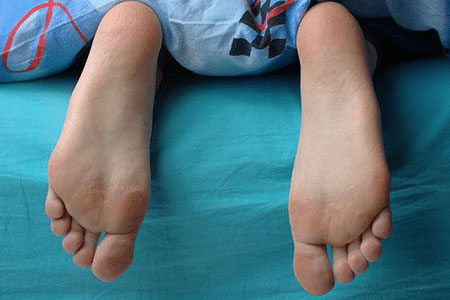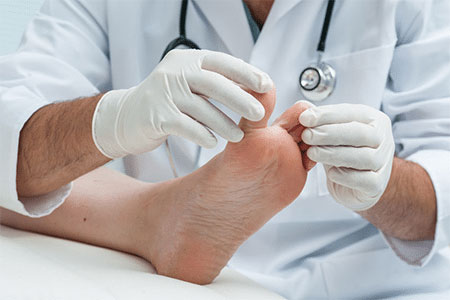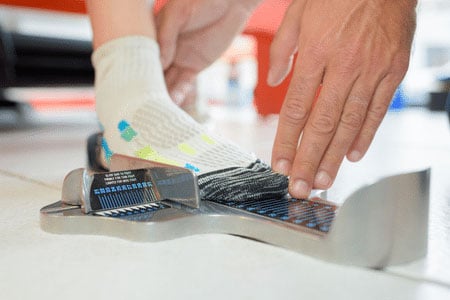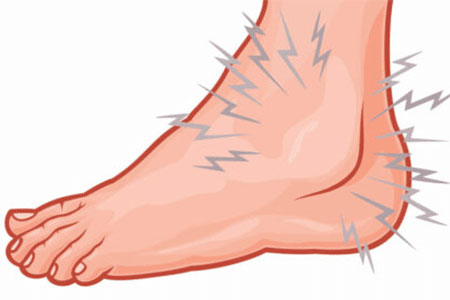Foot Problems from Shoes – The Nasty Bits

To keep your kids’ feet healthy you must provide them with the correct type of shoes in the correct shoe size, which involves the correct shoe length and the correct shoe width. Has your child developed a foot issue? Did you know that shoes that are too short, too long, too narrow or too wide can lead to foot issues? Foot problems from shoes include:
- Calluses
- Corns
- Plantar Warts
- Ingrown Toenails
- Athlete’s Foot
- Foot Odor
What Role Does Genetics Play in Your Child’s Foot Problems?
Heredity plays an important role in the kind of feet we have and even our natural gait. For example, genetics or heredity will influence the type of arch we have, if one or both parents are flat-footed, children will likely be flat-footed as well. Excessive out-toeing is an indicator of the mark of genetics.
The most effective way to treat and prevent your child’s foot issues is to provide them with the correct type of shoes.
What Role Do Shoes Play in Keeping Your Children’s Feet Healthy?
Certain shoes will provide more comfort and support to your child’s feet. These shoes come with extra padding well-padded around the heels to prevent blisters, and they are also deep and come with a round toe-box to prevent your kids’ toes from rubbing against each other or the side of the shoes. Please keep in mind that the shoes that I will describe below are also available in different widths such as medium, wide, and extra wide.
The Six Most Common Foot Problems From Shoes
1️⃣ CALLUSES
Most parents are not even aware of what a callus is, and they probably think that children can’t get them. Calluses are a hardening of the skin, which is nature’s way of protecting the skin below in an area that has been exposed to friction. The overwhelming downside is when calluses develop compact thickness on pressure-sensitive parts of the foot, such as under the ball or under the big toe.
Calluses then become painful, much like having a pebble under the foot. Make sure you fit your kids’ in the right pair of shoes to prevent calluses from forming since shoes that are not fitted properly are the main cause of most calluses.
If you are not sure about how a callus looks like, take a look at the picture below and notice how the child has not one but several calluses on his feet.

How can you get rid of your kids’ calluses?
The remedies are quite simple. If not severe, the first step to try is to soak and rub off with a rough towel or pumice. If this doesn’t work, you can try a product I recommend and it’s known for reducing the callus or eliminating it completely named Heel-Tastic. I will show you the product at the end of the post. If severe, the callus may be removed by a podiatrist. Keep in mind that the callus itself is sometimes a symptom of foot imbalance, or a more serious problem concealed inside the foot.
2️⃣ CORNS
Oh, the corns! These are very hard to get rid of so prevention is key. The technical term for a corn is a heloma. There are two main types of corns: hard and soft. The hard corn usually starts as red skin, followed by a coating of callus. This then develops into a hard corn. Most hard corn will develop in the small toe, but they are also seen on the top or sides of the feet. This is due to steady pressure and friction from shoes that are not fitted properly.
This is how a corn looks like:

How can you get rid of your kid’s corns?
My first recommendation will be to start with salicylic acid. Applying this or ointment such as Heel-Tastic once a day should reduce the pain and inflammation significantly. Keep in mind that the hard corns will likely return until you take corrective action about the shoes your child wears.
3️⃣ PLANTAR WARTS
Plantar warts are different than regular warts in the sense that they are much more painful. If your child starts complaining about having pain under their feet, like they are walking on a small stone, you should have your child checked to see if he/she developed plantar warts. These are caused by a virus that is usually transferred by surface connection.
Children that spend a lot of time barefoot (which is recommended for healthy foot development) can be infected if they are playing on surfaces where other children were carrying the virus on their feet.
Another thing to keep in mind is that if the skin is wet and softened after a long swim or bath, or by not wearing the right kind of socks, you are giving the virus a way to get into your child’s skin.
I explain in more detail the key role that socks play in keeping our kids’ feet healthy in another article. I also provide a description of the best socks for kids.
Below you can find a picture of a foot with a plantar wart:

How can you get rid of plantar warts?
The first step will be to consult with your podiatrist or dermatologist to make sure you are dealing with plantar warts. There are several home remedies that you might want to try but I describe the most effective way that has proven to work and that is the Freeze it off (Cryotherapy). Even though your podiatrist or dermatologist might offer to do it themselves you can try a more economic way by trying “Compound W Freeze Off” or “Dr. Scholl’s Freeze Away” that I describe at the end of the post, which also has very simple instructions.
This method I recommend will only take 1–5 applications over 1–2 weeks to completely remove the wart. Keep in mind that your child might feel the cold sensation painful but on the plus side, this is a relatively fast process compared to other treatments. I want to make you aware that it is common to be a deep hole in the bottom of your child’s foot where the wart comes out. All you are seeing is the new skin that has grown around the dead virus.
4️⃣ INGROWN TOENAILS
Ingrown toenails can develop extremely fast. They can either be caused by cutting your children’s toenails too short or by wearing poorly fitted shoes. Avoid purchasing shoes that are too short or too narrow since they will cause the nail to grow into the soft skin. Socks that are too tight should also be avoided since they will only make the problem worse. Sneakers with extra depth and rounded toe-boxes are ideal for children with ingrown toenails.
How can you fix an ingrown toenail?
The only safe and successful treatment is the removal of the nail edge, plus disinfecting and packing, by a podiatrist. The next step will be to always cut his/her toenails straight across rather than in a rounded shape.
5️⃣ ATHLETE’S FOOT
I want to clarify that not only athletes can get this itchy condition, kids might get it too. One of the main causes is hot and sweaty sneakers. The infection will only occur if conditions are right for the fungus to grow. The fungus likes it wet, that is the reason why children should avoid wearing tight shoes or shoes that have minimal breathability. If your child tends to sweat a lot please consider switching his/her socks twice a day and buying socks that allow the feet to breathe.

How can you get rid of athlete’s foot?
The milder forms can usually be remedied by any of the commercial products available below. But advanced or persistent cases should be seen by podiatrists or dermatologists. Wearing a shoe that breathes properly is key in helping get rid of athlete’s foot.
There is an article I wrote where I describe the most breathable shoes for children.
6️⃣ FOOT ODORS
Ohhh the foot odor! Some children’s feet sweat more than others! Some of the reasons are wearing footwear with no breathability or tight fitting shoes. Excessive foot perspiration creates foot and shoe discomfort. Avoid buying low quality shoes made out of plastic, rubber or polyurethane. Investing in a good quality pair of shoes with breathable materials such as leather, cloth, canvas or newer mesh materials is highly recommended.

How to prevent your kids’ feet from smelling so much?
Make an effort to keep your little one’s feet as dry and clean as possible. Switch his/her socks twice a day if they are damp. Buy properly fitted shoes with breathable materials to provide proper air circulation to avoid bacteria to grow. I wrote a post about shoes that breathe better and that will prevent your kids’ feet from smelling excessively.
Take into consideration that all of these foot issues described above can be avoided by wearing the correct type of shoes and socks.
I will provide you with a selection of the best types of shoes to keep your kids’ feet healthy. However, to prevent foot issues, your child must wear the correct shoe size.
How to Retrieve Your Child’s Exact Foot Length and Shape

I always recommend parents take their children to their local fitting children’s shoe store that they trust, the issue is that most fitting stores have been closing down and parents need to end up buying their kids’ shoes online. There is nothing wrong with this, but you must know your child’s exact foot size to know what size to order.
I created a resource that showcases the best-fitting children’s shoe stores by state.
If after looking at that resource you still can’t seem to identify a shoe store in your area, then proceed to take a look at an article I created that describes the simplest, yet most effective way to figure out your child’s foot size from home.
In that article I help parents determine their child’s exact foot size and whether the child has narrow, medium, wide, or extra wide feet. I also will be able to tell you whether your child has a high instep or not.
I only write reviews of shoe styles that I have fitted before, otherwise, I wouldn’t know how well-made they are, the amount of support that they provide, and how they fit. Disclosure: Keep in mind that we may receive commissions when you click our links and make purchases.
The Best Kids’ Shoes to Prevent and Treat Foot Issues
These shoes can fit children with different foot shapes such as medium, wide, and extra wide as they all provide extra depth and rounder toe-boxes.
- Shoe style 3537 by Tsukihoshi
- Fits medium and wide feet
- Leather/mesh upper
- Hook and loop closure system for easy on and off
- Durable rubber outsole designed to withstand wear-and-tear
- The insoles are Infused with natural Green Tea extract (no chemicals)
- Machine washable
- Order this shoe the same size as your child’s current foot size (shoe fits long)
- Shoe style 2510 by Tsukihoshi
- Fits medium and wide feet
- Generous toe box provides room for healthy foot development
- Adjustable hook-and-loop strap
- The insoles are Infused with natural Green Tea extract (no chemicals)
- Machine washable
- Order this shoe the same size as your child’s foot size (shoe fits long)
- Shoe style Saylor by See Kai Run
- Fits medium and wide feet
- Hook and loop closure for easy on off
- Lightweight, water-friendly open mesh upper with rubberized overlays
- Oversized openings for easy-on
- Removable EVA sockliner with mesh overlay
- Order this shoe a whole size larger than your child’s current foot size
- Shoe style Saylor by See Kai Run
- Fits medium and wide feet
- Hook and loop closure for easy on off
- Lightweight, water-friendly open mesh upper with rubberized overlays
- Oversized openings for easy-on
- Removable EVA sockliner with mesh overlay
- Order this shoe a whole size larger than your child’s current foot size
- Shoe style Wader 21 by Geox
- Fits medium and wide feet
- Breathable mesh upper
- Unique microporous membrane that absorbs and expels sweat while keeping water out
- Lightweight and flexible with padded collar and tongue for added comfort
- Machine washable
- Order this shoe half a size larger than your child’s current foot size
- Shoe style Sprintye 16 by Geox
- Fits medium and wide feet
- Breathable mesh upper
- Removable insoles
- Lightweight and flexible with padded collar and tongue for added comfort
- Machine washable
- Order this shoe half a size larger than your child’s current foot size
- Shoe style Buller by Geox
- Fits medium and wide feet
- Hook and loop closure for easy on off
- Unique microporous membrane that absorbs and expels sweat while keeping water out
- Order this shoe a whole size larger than your child’s current foot size
- Shoe style Artin 2.0 by Stride Rite
- Fits medium and wide feet
- Breathable mesh upper
- Removable insoles
- OrthoLite® memory foam for enhanced comfort
- Machine washable
- Order this shoe a whole size larger than your child’s current foot size
- Shoe style 3570 by Tsukihoshi
- Fits medium and wide feet
- Heel Stabilizer – Long heel counter provides stability
- Velcro closure
- Machine washable
- Removable insoles
- The insoles are Infused with natural Green Tea extract (no chemicals)
- Order this shoe the same size as your child’s foot size (shoe fits long)
- Shoe style 3584 by Tsukihoshi
- Fits medium and wide feet
- Breathable mesh upper
- Removable insoles
- The insoles are Infused with natural Green Tea extract (no chemicals)
- Machine washable
- Order this shoe the same size as your child’s foot size (shoe fits long)
- Shoe style Velocity by Tsukihoshi
- Fits medium and wide feet
- Leather/mesh upper
- Hook and loop closure system for easy on and off
- Durable rubber outsole designed to withstand wear-and-tear
- The insoles are Infused with natural Green Tea extract (no chemicals)
- Order this shoe the same size as your child’s current foot size (shoe fits long)
- Shoe style 1521 KAZ by Tsukihoshi
- Fits medium and wide feet
- Breathable mesh upper
- Removable insoles
- The insoles are Infused with natural Green Tea extract (no chemicals)
- Machine washable
- Order this shoe the same size as your child’s foot size (shoe fits long)
- Shoe style M2P Player by Stride Rite
- Fits medium and wide feet
- Breathable mesh upper
- Removable insoles
- OrthoLite® memory foam for enhanced comfort
- Machine washable
- Order this shoe a whole size larger than your child’s current foot size
Are Any Other Shoe Choices Available?
Do not hesitate to contact me directly at my e-mail if you have any further questions or if you need a different pair of shoes for your child. My e-mail address is:
Do you have a child that has developed any of the foot problems mentioned above? Have you found a solution to the problem? Did you use any particular product? Please share your thoughts and experiences so we can all benefit from them!

















Fantastic article! I have two young boys and we have fought some of these foot problems. It can be exhausting keeping up with their ever growing feet! That makes the cost of shoes somewhat of a concern. But certainly investing in a good brand that will last is helpful! I’m headed over to check out your shoe reviews. Great info!
Heather,
Investing in a good pair of shoes for your boys is a smart decision. You will end up saving money and time, and most important you will avoid having to deal with foot problems.
I don’t know that it will be hereditary when it comes to feet odor. I am so curious about it because I look after two children, but not all of them have feet problem, they are siblings but only one among them have that smelly feet which I can’t stand. Every week I must wash the shoes, even if they are wearing socks, we use a lot of products to help reduce the smells, but still not work at all.I tried your simple tips about trying to put theirs shoes in an open air, and it has helped some.
Renelyn,
Have you looked at the type of shoes that they are wearing? Shoes with non-breathable uppers should be avoided. Make sure the parents are buying them shoes that use mesh so they can allow the feet to breathe. You should also check my post about socks since these play a key role in foot odors. Some type of socks wick moisture away from your feet and prevent bacteria from growing.
Hi Juan enjoyed your post. You are spot on that a lot of foot problems could be avoided if correct footwear is worn. My feet are in a horrendous state and very painful thanks to years of wearing killer heels. I now can not walk without a heel because my ligaments and tendons in my ankle and calves have shortened. Wish I had listened when I was told I would pay in later life for my choice of footwear. I also suffer with collapsed arches which are very painful. You would think I would have learn’t a lesson but no I still titter around on high heels. I may learn one day.
Jo,
I am sorry to hear that. Hopefully you will find a good supportive pair of shoes that it will prevent your arches from collapsing and take away some of the pain you are experiencing.
I’ve been a firm believer of good footwear and have never worn pointy toe shoes or shoes too high. Because of my insistence wearing good quality footwears, my children have also had to wear good quality footwear. None of us have had issues with our feet.
However, my sister from a young age insisted that she was a size UK3/36 even when it was confirmed that she was and still is a size UK4/37. We still have no idea why she wanted to be a size smaller, and why she thought it was ok to squeeze into smaller fitting shoes. It must have been so painful. My sisters feet paid for it in the end because she now has twisted feet, bunyans, corns Ingrown nails and more recently she acquired athletes foot. This is so sad so if anyone reads my comment, then please listen to Juan because he spot on and knows his stuff. 🙂
Sharon,
Your belief in good footwear has paid dividends at the end and your children have healthy feet. Maybe your sister did not like shoes that make her feet look too big, unfortunately that is an argument that some people make and do not realize the damage they are doing to their feet. I am glad you found the post informative.
I am a victim of calluses myself, No matter what I did, they either stayed or took a while to go away. I own some Air Max’s, but maybe it is tome to invest in the shoes shown.This information is exactly what I needed. An appointment with the podiatrist is well overdue! Thank you!
I would recommend having your feet measured, and investing in a pair of well fitted shoes. Nike footwear tends to run in the narrow width, and my gut is telling me that you are wearing shoes that are too narrow for your feet. I would like you to follow up here and tell me if the calluses are going away.
One of the banes of today’s living comes in manufactured shoes. I suffer from this problem with the fact that my right foot is much wider than the left. Shoes were once tailored to each person’s needs, but such tailoring is now extremely expensive and outside of most people’s reach.
Another issue I have come across, and has been covered above, and this is, unbreathable conditions with shoes that are made of plastic. These imitation leather shoes that can often be purchased at low pricing come from low-end outlets and mail order. These should be avoided at all costs!
Such shoes will cause or promote all of the conditions discussed above.
Daniel,
I am sure you know by now, but I wanted to make sure that when you are purchasing shoes for yourself you are fitting your right foot, which from what you wrote is the widest and probably the longest.If you feel like there is a lot of extra space in your left foot, you can always add an insole or a tongue pad. I agree with you that some low pricing shoes end up creating foot problems.
I never even thought about this. What can I do about the width? Would an insole be sufficient for this? Yes, my right foot is much larger than the left and my face is also asymmetrical in the same way, which is noticable. I guess this problem is very common in humans.
Daniel,
You must fit the right foot first (the longest one) with the appropriate width and length. Then, I would recommend putting an extra insole in the left shoe so it does not feel so wide. If that does not help, then I would recommend getting different shoe sizes. Most store would charge you full price for the first pair and give you the other one at 50% off. Hope this helps.
This is great information.
Thank you,
Eileen
Eileen,
I am glad you found the post informative.
This article is very inspiring to think about how someone could have gotten certain foot problems.
As a former nurse, I do know about these conditions, however, reading about it that heredity does play a huge role, certainly got me thinking too where some foot problems of mine are coming from.
Altogether a very interesting article with lots of useful information.
Sylvia,
I hope your foot problems are nothing major. Let me know if there is any way I can help, there is a lot of products out there, from specialized shoes to orthotics.
My goodness, I had no idea how complex and involved is the proper care of our feet when it relates to our shoes! You really enlightened me with this very thorough and informative article. I liked the advice to wear shoes with “breathable” uppers and to let all shoes “air out” now and then, too.
Marvin,
It does sound complex, but keep in mind that once you start providing proper care to your feet you will be amazed about the difference this will make. I am glad you found the post informative.
Very good information. The feet are so important and yet we tend to take them for granted. UNTIL we have a problem that causes us pain or embarrassment!
Thank you for providing this very helpful information.
Eileen
Eileen,
All the foot problems described in the post can be AVOIDED by wearing the correct pair of shoes 😉